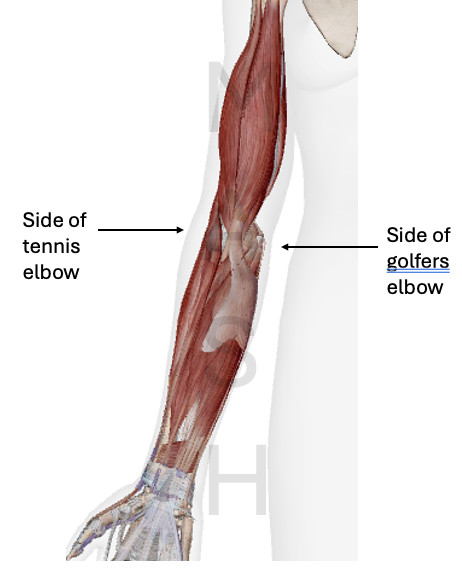When the Outer Elbow Aches
Tennis elbow, also called lateral epicondylitis, is a condition where the tendons on the outer side of the elbow become irritated or overloaded. Despite the name, you don’t need to play tennis to develop it, any activity involving repeated gripping, twisting, or lifting can lead to this problem.
The pain usually starts gradually and may spread from the elbow to the forearm and wrist, making it difficult to carry objects, shake hands, or even hold a cup of coffee.
Spotting the Symptoms
Common signs of tennis elbow include:
- Pain or burning on the outer part of the elbow
- Tenderness when pressing on the bony area of the elbow
- Weakened grip strength
- Pain that worsens with lifting, gripping, or twisting motions
- Discomfort when typing, using tools, or carrying bags

Why Does Tennis Elbow Happen?
The condition occurs when small tears develop in the forearm tendons that attach to the elbow. Causes and risk factors include:
- Repetitive wrist and arm motions (typing, painting, carpentry, sports)
- Poor technique in racquet sports
- Occupations involving heavy or repetitive lifting
- Age (commonly affects adults between 30 and 50)
How It’s Diagnosed
An orthopaedic doctor will take a history of your symptoms and examine the elbow, wrist, and forearm. Specific tests may involve resisting wrist or finger movement to reproduce pain. X-rays or MRI scans are sometimes used to rule out arthritis or other injuries.
Treatment Options for Tennis Elbow
Most cases improve with non-surgical treatment. The goal is to reduce pain, support tendon healing, and restore strength.
Self-Care and Lifestyle Adjustments
- Resting the affected arm and avoiding aggravating activities
- Applying ice packs to reduce inflammation
- Using a forearm strap or brace to relieve tendon stress
Medications
- Pain relief or anti-inflammatory medicines may be prescribed for symptom control
Physiotherapy
- Stretching and strengthening exercises for the forearm muscles
- Techniques such as ultrasound therapy or shockwave treatment
- Advice on ergonomics and sports technique correction
Injections
- Corticosteroid or other biologic injections may be considered for persistent pain
Surgery
- Rarely needed, but may be considered if pain persists after 6–12 months of non-surgical care
- Surgical options aim to remove damaged tendon tissue and promote healing
Everyday Tips for Recovery
- Warm up and stretch before sports or heavy lifting
- Use proper form when lifting or gripping objects
- Take breaks during repetitive tasks
- Use ergonomically designed tools, racquets, or keyboards
- Strengthen forearm and shoulder muscles to reduce tendon strain
When to Seek Medical Help
See a doctor if:
- Elbow pain persists beyond a few weeks despite rest
- Weakness in the grip interferes with daily activities
- Pain worsens over time or spreads down the arm
- You are unable to carry objects without discomfort
Book a Consultation for Elbow Pain
If you are experiencing persistent elbow pain or suspect tennis elbow, our team at Mash Spine & Orthopaedics can provide a detailed evaluation and recommend appropriate treatment options for your condition.
- Farrer Park Medical Centre, 1 Farrer Park Station Road, #07-14 Connexion, Singapore 217562
- Call +65 6518 9545
- Book your Appointment Today
Tennis Elbow – At a Glance
What it is:
- Irritation of the tendons on the outer elbow from overuse or strain
Key Symptoms:
- Pain and tenderness on the outer elbow
- Weakened grip strength
- Pain when lifting, twisting, or gripping objects
Who’s at risk:
- Racquet sport players
- Workers in manual or repetitive tasks (painters, carpenters, typists)
- Adults aged 30–50
Treatment Options:
- Rest, ice, braces
- Medications for pain and inflammation
- Physiotherapy and ergonomic adjustments
- Injections for stubborn cases
- Surgery only if long-term non-surgical care fails





